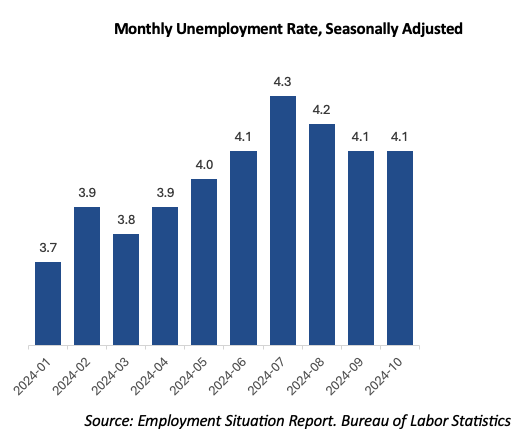
The U.S. economy added the equivalent of a large company in October, according to data released Friday (Nov. 1) from the Bureau of Labor Statistics.
More than 12,000 positions were added last month, which missed estimates of 100,000 roles. Stocks roared out of the gate, up 0.8% Friday morning.
The read-across is that the Federal Reserve could cut interest rates yet again, as the optics of a slowing job market might push the central bank to trim its benchmark fed funds rate consistently over the next few months.
Beyond the noise surrounding the report — where hurricanes and strikes slowed hiring — the unemployment rate was unchanged in the past month at 4.1%, while the number of unemployed individuals was little changed at 7 million. These measures are somewhat higher than a year earlier, when the jobless rate was 3.8%, and the number of unemployed people was 6.4 million.
The relative stability was consistent across major industries, including mining, quarrying, and oil and gas extraction; wholesale trade; retail trade; transportation and warehousing; information; financial activities; leisure and hospitality; and other services.
 The Friday data syncs with the Job Openings and Turnover Survey data released earlier this week, which recorded that job openings in September were largely unchanged versus the month prior at 7.4 million on the last business day of September, while both hires and separations were also stable.
The Friday data syncs with the Job Openings and Turnover Survey data released earlier this week, which recorded that job openings in September were largely unchanged versus the month prior at 7.4 million on the last business day of September, while both hires and separations were also stable.
But there are some signs that the very smallest of firms — the type that populate the Main Street economy — are seeing some stagnant trends. As of September, establishments with one to nine employees showed little or no change in job openings, hires, quits and total separations rates, while the layoffs and discharges rate increased. For establishments with 5,000 or more employees, the job openings, hires and total separations rates showed little or no change.
Average hourly earnings were up 0.4% on a month-to-month basis, while growing 4% year on year. That’s a rate that is outpacing inflation. But other data showed that expenses are outpacing income growth, so the growth in those earnings is being more than offset.
The overall trend is toward normalizing — a soft landing where the unemployment rate stands in the high 3% to low 4% range. The latest information presents a confusing picture, at best, and it may be the case that individuals and households gauge any job-switching prospects with some caution.
And when caution is a key mindset, tightening some household expenses may be the result, at least until the jobs picture comes into better focus.